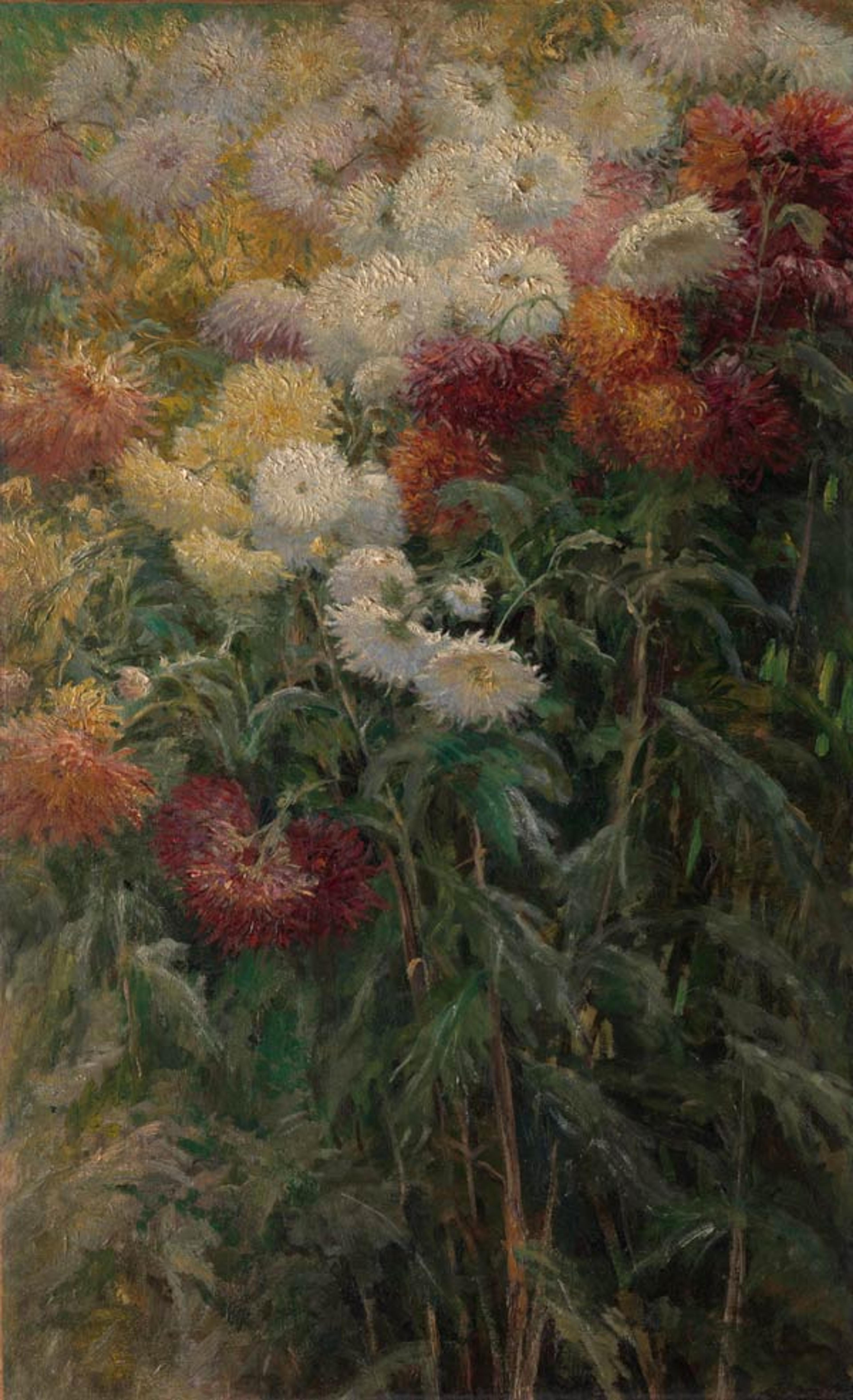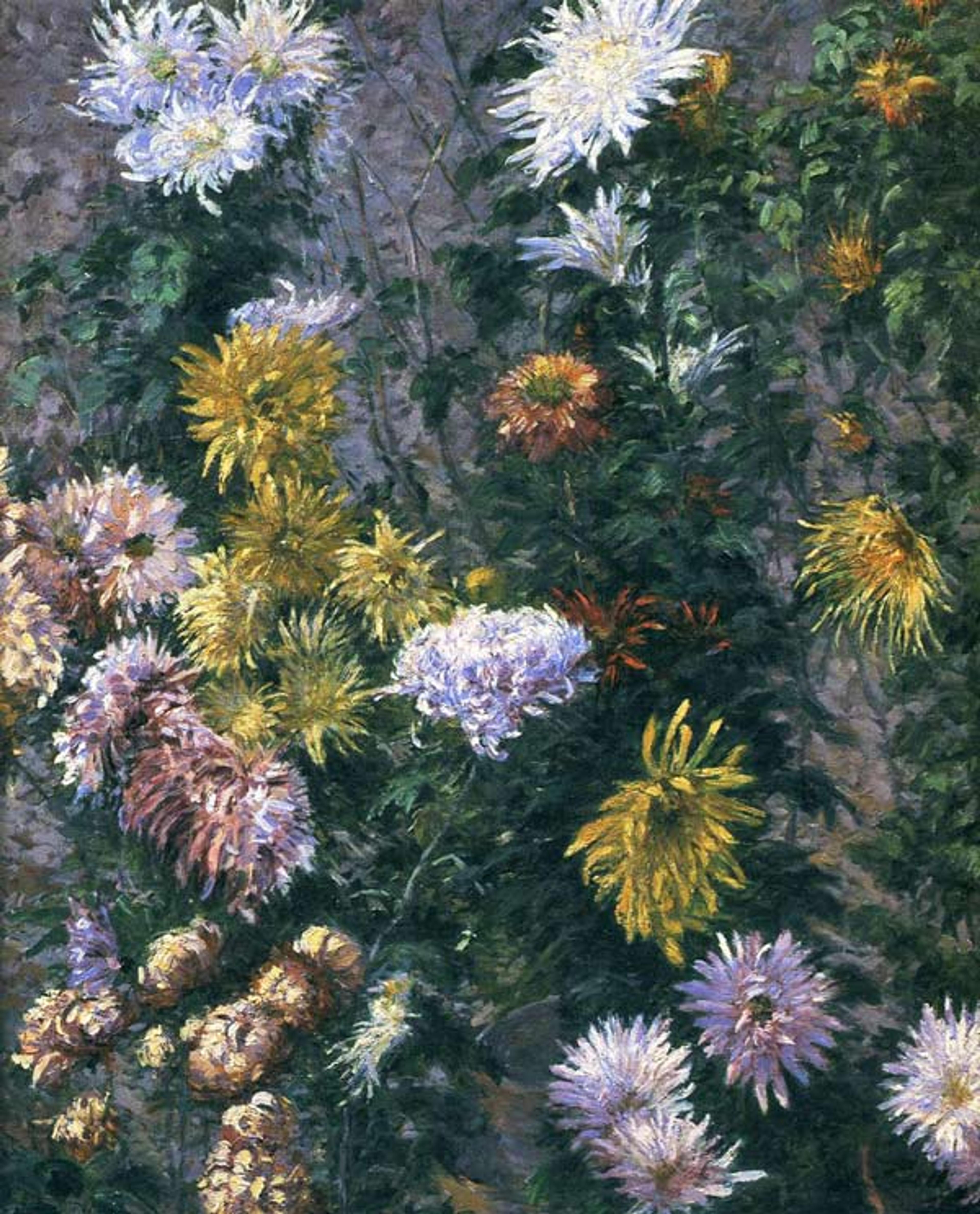Caillebotte's Chrysanthemums; or, Unexpected Encounters with Impressionist Interior Design

Gustave Caillebotte (French, 1848–1894). Chrysanthemums in the Garden at Petit-Gennevilliers, 1893. Oil on canvas; 38 5/8 x 23 1/2 in. (98 x 59.8 cm). The Metropolitan Museum of Art, New York, Gift of the Honorable John C. Whitehead, 2014 (2014.736)
«Gustave Caillebotte's Chrysanthemums in the Garden at Petit-Gennevilliers is one of the most exciting recent acquisitions in the Department of European Paintings. Now on view in gallery 824, not only is the painting the Met's first work by the artist, but it encapsulates a fresh approach to still life unseen before its time.»
Caillebotte completed this highly unusual floral still life in 1893 while living in Petit-Gennevilliers, a suburb of Paris on the banks of the Seine near Argenteuil. The Impressionist painter had moved there to recapture the country life along the river he had cherished at his family home in Yerres, which had been sold off following his mother's death. He cultivated several types of flowers on the property at Petit-Gennevilliers, including roses, irises, and what might seem plebeian flowers to our contemporary eye but were actually prized at the time as an exotic reference to all things Japanese and Chinese, chrysanthemums.
The moment captured is filled with sunlight that falls from the left of the flowers, casting a shadow on the green stalks at right and a glow of light that particularly kisses the white, yellow, and orange flower petals. Our viewpoint in relationship to the flowers is from above, yet intimately close, as if we have arrived upon a thicket of the blooms growing wild in the garden or, possibly, in Caillebotte's own greenhouse, where he cultivated many different flowers. This viewpoint might well have been seen as shocking to Caillebotte's contemporaries, who were used to encountering floral still lifes either in the form of cut flowers in a vase seen from close up in an interior scene, or flowers in garden landscapes as seen from a distance (then typically classified as landscapes, rather than still lifes). Here, however, the artist renders the chrysanthemums with the close study one might give to a cut-flower piece, while clearly revealing the flowers as still growing. The composition is cropped at lower left and upper right to emphasize the abundant, densely packed blooms.
While researching the painting, I learned that the eminent scholar, curator, and professor Kirk Varnedoe—a truly great teacher of mine—had once discussed the painting in terms of the near vision of the instantaneous "snapshot" glance explored by both the Impressionists and other artists of the day.1 The foreground looms up to such a degree in this canvas that there is nothing to see beyond it. It is as if our vision has been momentarily subsumed by the ripe fullness of the blossoms as we pass.
Where could such a painting be placed, I wondered? It was only when I considered it as an unframed composition, in light of having come from the current exhibition Discovering the Impressionists: Paul Durand-Ruel and the New Painting at the Philadelphia Museum of Art, that it all made sense to me. In that exhibition one can see Claude Monet's painted panels for the doors to Paul Durand-Ruel's living room, a group of floral- and fruit-covered painted canvases from 1883, currently on display in a door frame. In some of the smaller canvases on the lower door panels, we see Monet taking a viewpoint from above the fruits, as if they were encountered from above when approaching the door. That was it, I thought! Caillebotte intended this panel to be seen from above, maybe even as a lower door panel.
Caillebotte had, indeed, been highly influenced by the garden imagery of his friend Monet in these later years and had seen the doors made for Durand-Ruel, the prime art dealer for the Impressionists. In fact, as I later read from Varnedoe, Caillebotte himself created another two sets of doors that we know of—for his own dining room at Petit-Gennevilliers, with orchids in his own greenhouse on view in the upper panels and other blooms on view, similarly from above, in the lower panels. Varnedoe wrote of Caillebotte's other known canvas depicting chrysanthemums, from 1893, Chrysanthèmes blancs et jaunes, jardin du Petit-Gennevilliers, in the collection of the Musée Marmottan in Paris, noting that "In this picture and in another of the same subject [the Met's Chrysanthemums in the Garden at Petit-Gennevilliers], the notion of a decorative panel may help to explain the shallow-field spatial organization and edge-to-edge even dispersal of the composition."2

Gustave Caillebotte (French, 1848–1894). Chrysanthèmes blancs et jaunes, jardin du Petit-Gennevilliers, 1893. Oil on canvas; 73 x 60 cm. Musée Marmottan, Paris
In specific, I would say that the Met's canvas was intended to be approached from the left, with the sun-kissed flowers looming up to our right and a bit below eye level. While the dimensions of the work are a bit larger than some of the door panels from Caillebotte's dining room, we can wonder if the work was intended as an accompanying decorative panel, perhaps intended to be set into a wall panel. Today, framed quite differently in the department's galleries for nineteenth-century art, it is hard to regain this original viewpoint. Take a moment and try, though, and you may find Caillebotte's probable original intent for this piece come alive for you as it has for me.
[1] Kirk Varnedoe, Gustave Caillebotte (New Haven: Yale University Press, 1987), 16.
[2] Kirk Varnedoe, Gustave Caillebotte, 176.
Related Link
Now at the Met: "New Arrivals in the European Paintings Galleries" (July 1, 2015)
Jane Becker
Jane R. Becker is the collections specialist in the Department of European Paintings responsible for 19th-century European paintings.